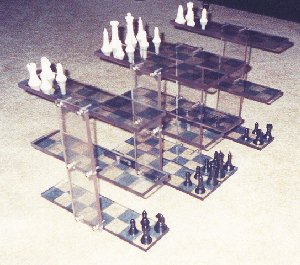
Chess to the Third Power. Played on a three levels, separate and transparent. This chess game variant has some unique features. With old rules and few new rules added with the same constant pieces.
More than one way of board game set up, with more than one game to play.
Chess to the Third Power, was created by James Melander, patented, copyrighted, and trademark established in 1998. This unique game was invented by Mr. Melander for one reason, to make chess more fun. With that in mind he created a much more advance version of chess, harder and yet easier to play. With new moves for the standard pieces and new strategies to find.
Rules for Chess to the Third Power
To set up board
- Set boards into three sections. one on the left, two joining on the middle, and one on the right . Boards may be placed into two sections, two and the left and two on the right. See diagram.
- Make sure you have enough room to move pieces between board sections, see diagram.
- Place white pieces on the top level, black on the bottom
- Board is see through with three full size boards stacked up directly above one another.
- Boards may be positioned in any other comfortable fashion.
Rules for play :
Pawns
- Pawns are only able to move forward one space at a time, except on the first move you may move two spaces forward.
- If the space ahead is occupied you must wait until that space is clear.
- The pawn is able to capture pieces on the right or left diagonal spaces that are ahead of the pawn .
- To change levels a pawn must take a piece that is either right or left diagonal spaces that are ahead of above or below the level the pawn is on.
- If a pawn makes it across the board, regardless of which level it's on, it may be traded in for any piece except the king.
Bishop
- The bishop is able to move in a diagonal pattern either forwards or backwards, but only on their color.
- If an opponents piece is blocking the diagonal path it may be taken, but the bishop can not jump any piece in it's path
- To change levels the bishop must follow the diagonal pattern either taking a piece or moving multiple levels.
- See diagram.
Rook
- The rooks move in straight lines only to move or to capture.
- They can not jump over pieces but can take any in their path.
- To change levels the rook can only go up or down either taking a piece or move to different levels.
- See diagram
Queen
- Has both the movements of the bishop and rook.
Knight
- The only piece that can jump in a "l" shaped pattern
- Changing levels are also "l" shaped jumps
- See diagram
King
- The king can move only one square at a time following the rules for the bishop and rook but only one square at a time .
- The king can not move into check and must move out of check to continue play.
- To change levels the king must be in check.
- The king can only change levels once following bishop and rook movements, only one square at a time.
Game hints
- Watch for knight moves
- Diagonal moves are hard to see with level changes
- No two pieces can occupy the same square at the same time
- Only one piece can move at a time
- Only one piece can be captured at a time
- Checkmate can occur on the king's level
- Stalemate causes a tie where the king can not move but only in check
- En passant and castle moves are allowed
- Original chess can be played on top level
- Chess to the second power can be played with the same rules using two levels.


Contact information
If you want to have more information on this game or otherwise want to contact the inventor, email to him: (email removed contact us for address) free.com.Link
Check out the home page of this game:- http://home.surfree.com/Pipeline/sabrelab/chess3.htm. Home page of Chess to the Third Power.
Written by James Melander, (email removed contact us for address) free.com. Conversion to html by Hans Bodlaender.
WWW page created: February 3, 1999. Last modified: August 25, 1999.